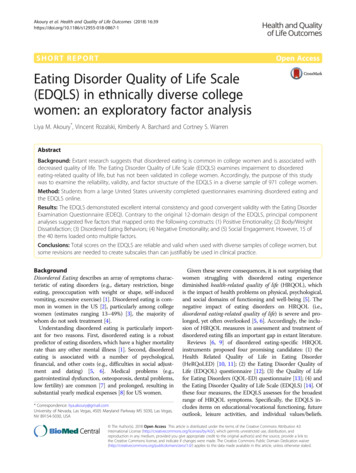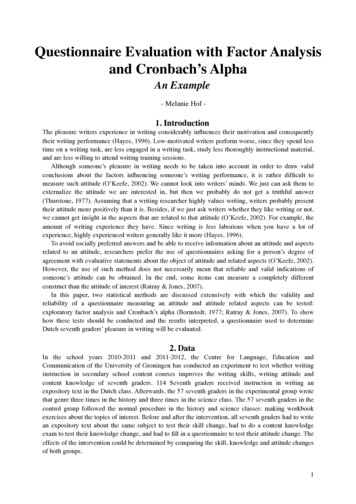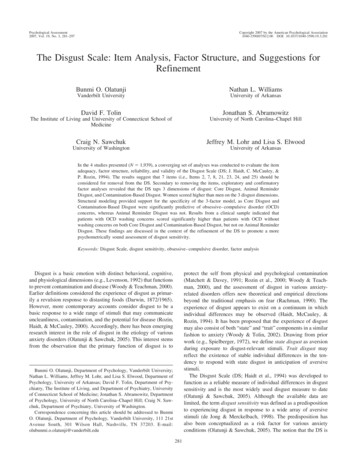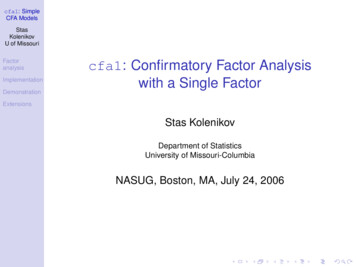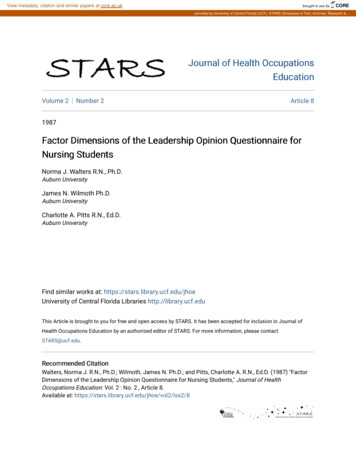
Transcription
View metadata, citation and similar papers at core.ac.ukbrought to you byCOREprovided by University of Central Florida (UCF): STARS (Showcase of Text, Archives, Research &.Journal of Health OccupationsEducationVolume 2Number 2Article 81987Factor Dimensions of the Leadership Opinion Questionnaire forNursing StudentsNorma J. Walters R.N., Ph.D.Auburn UniversityJames N. Wilmoth Ph.D.Auburn UniversityCharlotte A. Pitts R.N., Ed.D.Auburn UniversityFind similar works at: https://stars.library.ucf.edu/jhoeUniversity of Central Florida Libraries http://library.ucf.eduThis Article is brought to you for free and open access by STARS. It has been accepted for inclusion in Journal ofHealth Occupations Education by an authorized editor of STARS. For more information, please contactSTARS@ucf.edu.Recommended CitationWalters, Norma J. R.N., Ph.D.; Wilmoth, James N. Ph.D.; and Pitts, Charlotte A. R.N., Ed.D. (1987) "FactorDimensions of the Leadership Opinion Questionnaire for Nursing Students," Journal of HealthOccupations Education: Vol. 2 : No. 2 , Article 8.Available at: https://stars.library.ucf.edu/jhoe/vol2/iss2/8
Walters et al.: Factor Dimensions of Leadership Opinions for Nursing StudentsFACTOR DIMENSIONS OF THE LEADERSHIP OPINION QUESTIONNAIREFOR NURSING STUDENTSNorma J. WalterslJames N. WilmothCharlotte A. Pitts—Abstract:The purpose of this study was to develop factor dimensionsand scale the Fleishman Leadership Opinion Questionnaire accordingto responses of nursing students enrolled in Associate Degree Nursingand Bachelor of Science Nursing Programs.Validity of the Fleishmanscales, consideration and structure, for student nurses was testedusing factor analytic techniques.Best results were based on clarityof factor pattern loadings for 2 factor VARIMAX rotated solutionsfrom bounded raw data and covariance matrices.Both methods showed13 of 20 items recommended by Fleishman loaded as Fleishman structureitems and 12 of 20 loaded as Fleishman consideration items.Kaiser’smeasure of overall sampling adequacy for these nursing student datavaried between .72 and .97 at the item level.Reliability analysisproduced satisfactory reliabilities for composite estimates based1Norma J. Walters, R.N., Ph.D., is Assistant Professor and Coordinatorof Health Occupations, Auburn University; James N. Wilmoth, Ph.D., isProfessor, Research Consultant, and Statistician, Auburn University; andCharlotte A. Pitts, R.N., Ed.D., is Assistant Professor, School of Nursing,Auburn University.63Published by STARS, 19871
Journal of Health Occupations Education, Vol. 2 [1987], No. 2, Art. 8Factor Dimensions of LOQon non-Fleishman algorithms.Generalized results suggest that nursingstudents exhibit specific patterns of leadership attributes somewhatdifferent from the attributes suggested by Fleishman’s algorithms.Further research is recommended.Background for the StudyReports on the use of the Leadership Opinion Questionnaire (LOQ) forstudy of leadership styles of student nurses have been shown to be limitedI(Walters, Wilmoth, Pitts, 1987). Nevertheless, there was an attempt touse the LOQ in a previous study in an attempt to measure “structure” and“consideration” dimensions of leadership style of student nurses in Bachelorof Science in Nursing (BSN) and Associate Degree in Nursing (ADN) Programs.That previous study was based on reports of successful use of the instrumentin a variety of different organizational contexts:business, industrial,educational (leadership), hospital, nursing, research and developmental,military, and governmental.Further, there were also reports of successfuluse with female groups at the college level (Adams & Hicks, 1978; DeJulio,Larson, Dever, & Paulman, 1984).The literature left open the possibility that there were problemswith its application in some studies even though the LOQ had been appliedto a number of research situations.Researchers in some instances eithermodified the items (Duxburyj Armstrong, Drew, & Henly, 1984) or used onlya sample of the items on the two scales (Tucker, 1983).to the LOQ were undertaken without explanation.Such adjustmentsOther researchers (Baker,1975; DeJulio, et al., 1984) did not report internal consistencyreliabilities for the LOQ determined for the samples, perhaps they s2/82
Walters et al.: Factor Dimensions of Leadership Opinions for Nursing StudentsFactor Dimensions of LOQthat the Fleishman reliabilities generalized to the populations studied,or because the reliabilities determined for the focal groups wer’e verydifferent from those reported by Fleishman.On the other hand, manyresearchers reported assumed appropriateness of the LOQ because of itspurported self-report format, its ability to discriminate between twoleadership dimensions (consideration and structure), its acceptableFleishman standardized reliabilities and validities, and its extensiveapplication for the LOQ determined for their sam les, perhaps because theyassumed that the Fleishman reliabilities to normative data (Stun, Homer,& Boal, 1981).Analyses of student nurse data in the Walters, et al. (1987),study did not support application of the LOQ to their population of nursingstudents.Although Fleishman’s algorithms for scaling and aggregatingitem data were followed precisely, singularity of the correlation matrixprevented meaningful validation of the LOQ for measuring leadershipattitudes of nursing students.Reliability analyses produced negativevalues for every computed reliability suggesting the LOQ to be an unsuitablemeasure of opinions about leadership for the nursing student sample.Some reports of previous research claimed the LOQ to have potentialfor broad application in assessment and description of college studentleaders but failed to substantiate its application with reliability andvalidity analyses for the populations studied.Some reports demonstratedabsence of sex bias with the LOQ; others demonstrated it to discriminatebetween leaders and non-leaders; and still others provided some evidenceof its potential use in leader selection, and placement or training ofstudents.Walters, et al. (1987), recommended that future investigationsbe continued with consideration for the need thoroughly to examine65Published by STARS, 19873
Journal of Health Occupations Education, Vol. 2 [1987], No. 2, Art. 8Factor Dimensions of LOQreliability and validity properties of the instrument for the groupsIn the present study, the authors began at the beginning withmeasured.a complete reevaluation of factor structure and scale properties of theLOQ for nursing students.Many nursing programs, the greatest majority at the baccalaureatelevel, offer a management course during the last quarter prior to thepreceptorship.The purpose of including principles of management inundergraduate nursing programs is two fold:(a) to foster the developmentof leadership styles, and (b) to develop perception of self as a leader.This rationale served as the basis for investigating leadership attributesof student nurses in this study.For defining leadership attributes innursing students, the instrument of choice is the LOQ because of its varietyof applications in the literature.a!? The specific objectives for the study, formulated as research questionswere:1.Do nursing students in Associate Degree Nursing (ADN) and Bachelorof Science in Nursing (BSN) programs exhibit specific patterns of leadershipattributes?2.How does the factor structure of leadership attributes in nursingstudents differ from the population on which the factor structure wasdefined by Fleishman?3.What are the reliabilities of the principal items forming thefactor scales for nursing /iss2/84
Walters et al.: Factor Dimensions of Leadership Opinions for Nursing StudentsFactor Dimensions of LO(JMethodSubjectsStudents in two nursing programs in demographically similar (adjacent)communities volunteered as subjects.There were 40 university BSN students,13 junior college ADN students, and 46 (1986) and 31 (1987) junior BSNstudents.All 130 questionnaires were usable.All students signed consentforms under policy established by the educational institutions involved.Anonymity was protected through use of a numbering scheme.characteristics of the sample included:Demographic(a) both male and female, (b)both married and single, (c) previously and not previously employed withjob titles of nursing assistant and registered nurse, (d) age rangingbetween 21 and 31 years, and (e) grade point averages between 2.30 and3.90.Only four students had a previous college course in either nursingmanagement or leadership.InstrumentThe LOQ was utilized as a method for modeling leadership perceptionsin nursing students.It is purported to be a valid measurement scale usedfor analyzing leadership style and dimensioned on structure andconsideration (Fleishman and Harris, 1962, cited in Duxbury).Bothdimensions are relevant to managerial effectiveness.Consideration was defined as the ability to maintain mutual trust,respect, warmth, and introspect into the feelings of subordinates. Anindividual with a high score on the consideration scale was presumed ableto establish communication and rapport with subordinates.On the otherhand, a low score was believed to indicate an impersonal manager withingroup settings,Structure was defined by Fleishman (1969) as the extent67Published by STARS, 19875
Journal of Health Occupations Education, Vol. 2 [1987], No. 2, Art. 8Factor Dimensions of LOQby which individuals design and define their roles and the roles of thosearound them.The primary drive in the structure mode was proposed to begoal attainment for organizational purposes.DeJulio, et al.(1984) suggested use of “. . . the LOQ . . .wherefeedback concerning personal attitudes toward leadership may be ofparticular benefit to persons entering into occupations requiring managerialand leadership role functions.”The LOQ was claimed to measure generalleadership capacity in contexts other than business and industry.Prospective nurses would seem to require managerial and leadership skills;therefore, it was natural to select the LOQ as an appropriate instrumentfor this situation.But, reliability dsta were not reported for use ofthe LOQ with the student groups.In an earlier study (Walters, et al., 1987), student responses onselected items as recommended by Fleishman were recoded for scaling intothe two Fleishman scales:structure and consideration.The validity ofthose scales for many of the same nursing students at that time was testedwith factor analytic techniques.Inter-item consistency and split-half(odd-even) reliabilities were computed for all 40 items and for theconsideration and structure subscales.Had the tests materialized asexpected, additional descriptive data would have been calculated forcharacterizing leadership attributes of nursing students.However,measurement problems with the LOQ interfered with pursuing that goal.The first problem at that time occurred in defining constructs toestablish construct validity of the LOQ subscales for nursing students.Scaled according to Fleishman’salgorithm, the 40 items generated an ill-conditioned matrix for factor extraction using the SPSSX Factor iss2/86
Walters et al.: Factor Dimensions of Leadership Opinions for Nursing StudentsFactor Dimensions of LOQSub-Program.To determine the source(s) of singularity in the correlationmatrix, 40 Regression analyses (by LOQ items) were performed producing.RL’s ranging between .66 and .98, with 17 higher than .90. The regressionsinvolved, in turn, each LOQ item as a dependent variable regressed on theremaining 39 LOQ items.Factor analysis was repeated deleting the variable with the largestR2, and again produced an ill-conditioned matrix due to a determinant ofzero.In a second factor analysis a second LOQ item (with the second largest.Rz) was deleted with similar results.This process was continued until12 LOQ items with the largest R2’ s were deleted from the factor analyticmodels.Each of the 12 reduced matrices was ill-conditioned.It was obviousafter 12 attempts (still with R2’s greater than .93) that the LOQ was notfunctioning as expected with that sample of nursing students and wouldnot produce results comparable with other studies.The inquiry shifted to an examination of reliabilities.Fleishman’sLOQ, test-retest, and split-half (odd-even), reliability estimates forthe standardizing sample of first line supervisors and Air Force NCO’Sranged between .70 and .89 for the Consideration Scale and .67 and .88for the Structure Scale (Fleishman, 1969).Every reliability coefficient,uncorrected for anchor points (Wirier, 1971, p. 289) or corrected for anchorpoints, was a negative coefficient-- a condition indicating that noise inthe nursing student’s data exceeded information.Even though the LOQ has been empirically validated with managerialand supervisory personnel in a variety of environments such as industrial,business, and hospital (Fleishman, 1973; Kerr, Schriesheim, Murphy, &Stogdill, 1974; Korman, 1966; Schriesheim & Kerr, 1974, Schriesheim & Kerr,69Published by STARS, 19877
Journal of Health Occupations Education, Vol. 2 [1987], No. 2, Art. 8Factor Dimensions of LOQ1977), few published reports exist concerning its validation for studentleader populations.norms .IIIINevertheless, Fleishman’s LOQ manual presents collegeTwo studies (Capelle, 1967; Florestano, 1970) cited in Duxbury, etal. were concerned with performance on the LOQ of student leaders and nonreaders from “who’s who Among Students in American Colleges” and OmicronDelta Kappa (an honorary male leadership fraternity).Capelle (1967) foundsignificant differences between male college leaders and non-leaders onboth the consideration and structure scales.On the other hand, Florestano(1970) reported the structure scale differentiated former college leadersfrom non-leaders, but the consideration scale did not differentiate.Although both studies suggested that the LOQ showed promise for possibleuse with male college students, the LOQ in a prior application with nursingstudents (Walters, et al., 1987), by first reaction, was an unsuitablemeasure of their opinions about leadership.Measurement and statisticalmethodologies were adjusted for this report to clarify variations ofresponses of nursing students to the LOQ.Measurement and Statistical MethodologiesInherent properties of raw data have implications for methodologicaldesign, statistical analysis, and policy interpretations in any researchStudy.In the present study it is assumed that all raw data reflectobserved interval values or interval values resulting from coding:(a)dummy, (b) effect, or (c) criterion (scaling) coding. As such, inherentinformation contained as variability within the properties of the raw datadistribution may be cataloged.Variables may vary among themselves intheir units of measurement, central tendencies, frequencies of iss2/88
Walters et al.: Factor Dimensions of Leadership Opinions for Nursing StudentsFactor D mexsions of LOQvalues, cumulative frequencies, symmetries, clusterings of observed values,and in their relative minima and maxima with respect to frequency versusvalues graphs.IMYFurthermore each of the foregoing properties inherentlyaffect covariances and correlations that typically are fed to factoranalytic algorithms in statistical packages.One should recall thatwhatever affects covariances will affect off-diagonal elements of acorrelation matrix, and that in a true correlation matrix the principaldiagonal elements will always equal 1.00.All interested observers upon intuitive analysis of a raw data matrixwill observe the variations described in the foregoing.The interestedobserver may not unite those variations with mathematical properties oftheir corresponding raw data distributions.Because mathematical propertiesare essential for unraveling potential problems in statistical analysis,they will be defined informally in the following list:1.Mean:The typical or representative value around which deviationsof all observed values sum to zero.2.Range of observed values:3.Variance and standard deviation:upper and lower limits of variation.values reflecting tendency tocluster around mean.4.Skewness:value reflecting tendency to cluster at an extremeof the distribution.5.Kurtosis:value reflecting too little or too much spiking withrespect to the general frequency pattern along the range of the distribution.Based on the foregoing fundamental properties of data, a set ofspecific objectives was developed to guide study of the problems related71Published by STARS, 19879
Journal of Health Occupations Education, Vol. 2 [1987], No. 2, Art. 8Factor Dimensions of LOQto measuring nursing students with the LOQ.Those specific objectivesmay be stated as follows:1.To define relevant artifactual sources of variance in raw datamatrices.2.To describe transformations that selectively eliminate artifactualsources of variance from further statistical analyses.3.To develop a general context for transforming raw data matricesto reflect policy adjustments.4.To describe transformations that selectively adjust for specificsources of variance to reflect policy adjustments prior to subsequentstatistical5.analyses.To discuss interpretational implications for health occupationseducators within the statistical context of factor analysis.Antifactual Sources of VarianceAs data are ordinarily available for statistical analyses by computerprograms, they are laid out in rows and columns of a raw data matrix.When a computer program is opened the data are an abbreviation of theschematic presented as Figure 1.That abbreviation may be representedas the upper left rectangular portion continuing to the “nth” row and the“nth” column.An early task in analysis is to produce data for theadditional rows and columns shown in the schematic.Every variation betweennumbers in the schematic represents a source of interest to thestatistician.Some of the variation is a property of the unit and scaleof measurement used for each variable, some is a property of the statisticalmanipulations applied to the data.All variation due to unit and scaleof measurement may be considered as artifactual.The question is, s2/810
Walters et al.: Factor Dimensions of Leadership Opinions for Nursing StudentsFactor Dimensions of LOQCASEV A R I A B L EID123ROWRow1 2 3 . . . mVarianceSum e 1.sm————MEANVARIANCEv’ROWAMEANSR1AN COLc MEANSE:Schematic Context for Sources of Variance in Raw Data Matrices.artifactual variation be removed prior to further statistical analysis?Most professional educators have been taught routinely to remove bystandardizing the artifactualvariation.Perhaps some or all artifactualvariation should remain in the data, particularly if the raw data are basedon “meaningful units and scales” (Rummel, 1970, p. 289).When artifactual sources of variance are to be excised (removed oradjusted out), a statistician may employ one or more of the methodspresented in Table 1.(Each matrix element, for comparison, could beweighted by the reciprocal of the number of cases.)All methods in Table1 were employed at some stage in analyses of LOQ data collected from the130 student nurses in this study. Usually all vectors (variables) in araw data matrix are transformed using the same algorithm.A vector has73Published by STARS, 198711
Journal of Health Occupations Education, Vol. 2 [1987], No. 2, Art. 8Factor Dimensions of LOQTable 1lfethods for Removing (Adjusting Out) Artifactual Sources of Variance FromEither Row or Column Vectors of Raw Data MatricesSource with Resultof AdjustmentCorrecting Adjustment before Statistical AnalysisUnequal VectorLengths Adjustedfor Comparisonwith Length of anArbitrary Vector.Divide each element in the matrix by the lengthof arbitrary vector. Find inner products (moments).Divide each element in the matrix of inner productsby the maximum inner product.Unequal VectorLengths Normalizedto Length of 1.00DividevectorDivideby theUnequal VectorMeans Adjusted toMean of 0.00Subtract from each element the mean of all its vectorelements.Unequal VectorStd DeviationsAdjusted to StdDeviation of 1.00Divide each element by the standard deviation ofall its vector elements.Unequal VectorMeans and UnequalStd DeviationsStandardized toMean of 0.00 andStd Deviation of1.00From each element first subtract the mean, thendivide by the standard deviation, of all its vectorelements.each element in the matrix by its respectivelength. Find inner products (moments).each element in the matrix of inner productsmaximum inner iss2/812
Walters et al.: Factor Dimensions of Leadership Opinions for Nursing StudentsFactor Dimensions of LOQboth magnitude and direction.computing vector lengths.The magnitudes of vectors are known byOrdinarily vector directions are determinedfor vector pairs through computing cosines of angles between them (which,for standardized vectors, are correlation coefficients).From the raw data matrix itself may be calculated (a) Moments about(with respect to) their origin; that is, moments with respect to zero;(b) Moments about their mean (covariances); (c) Moments about the mean(of zero) of standardized data; that is, moments about zero having astandard deviation of one (correlations).Moments computed with respectto their origin make no adjustment to the data and should be used if thecomputerized statistical program of choice does not require a range between-1 and 1 such as in a correlation program.requires only a symmetric matrix.The theory of factor analysisHowever, if there are computerizedstatistical program requirements, they may be addressed through dividingevery value in the raw data matrix by the maximum value of the symmetricmatrix in a process known as bounding.An alternative is to adjust each symmetric matrix element with themean of all symmetric raw data matrix elements before proceeding withbounding, that is, dividing by that mean.Other adjustments made to theraw data matrix are designed to remove from the data, before factor analysis,whatever source of artifactual variance would be considered as confoundingto the factor analytic results:if differences in length are consideredas a confounding source rather than a source that promotes understandingof the factor analytic results, then those differences in vector lengthshould be excised.75Published by STARS, 198713
IJournal of Health Occupations Education, Vol. 2 [1987], No. 2, Art. 8Factor Dimensions of LOQThe same criterion should apply to each of the other adjustments:(a) for differences in means, (b) for differences in standard deviations,and (c) for differences in both means and standard deviations.Nothingin the mathematics prevents coupling adjustments for combinations ofartifactual sources such as coupling adjustments for differences in unitof measurement or of length with differences in means.Such adjustmentsare also referred to under concepts in the literature presented as:1.Scales of measurement considering distances between minima andmaxima, and actual values used with their between value properties (nominal,ordinal, interval).2.Scaling of variables (vectors) with a “scaling factor” to lengthenor contract their corresponding vector lengths in the vector space of thedata matrix.3.Precision of measurement dealing with arbitrariness of units ofmeasurement and meaningfulness of units of measurement chosen for a study.4.Factor analysis of covariance or correlation matrices applyingthe technique to one of two stages of adjustment correcting raw dataImatrices (a) for differences among variable means, and (b) for differencesamong both variable means and standard deviations.It should be emphasized that direct factor analysis of unadjustedraw data preserves both mathematical magnitudes and patterns of valuesin the raw data distribution.Uncorrected variances and covariances arebased on unadjusted raw data, before removing influence of length, centralItendency, variability, symmetry, and peakedness.In short, uncorrectedvariability and covariability are essentially raw data sums of squaresIand cross products.But, raw data matrices may need resealing (for iss2/814
Walters et al.: Factor Dimensions of Leadership Opinions for Nursing StudentsFactor Dimensions of LOQby a statistical package) to a range of values bounded to simulate acorrelation matrix:to 1.-1 to 1; or to values within this range such as OMoreover, deficiencies in psychometric properties of an instrumentmay require that adjustments be made to measurements generated by theinstrument.adjustments.If so, considerations in the foregoing may guide thoseIt was the intent of the authors for this study to defineobjectively and precisely appropriate adjustments that could be made toLOQ data matrices for nursing students such that research reports generatedin that segment of the health occupations professions may better be comparedwith findings in other fields.Eliminating Artifactual Sources of VarianceBackground for the principle that a research should remain in fullcharge of all data adjustments has been presented.Itwasnotedthroughoutthe foregoing sub-sections under Methodology that a variety of artifactualsources of variance can affect statistical procedures based on raw datamatrices.What has not been presented is the notion that the researchershould take care not to excise more information than is appropriate.Theconsequence of such carelessness may be matrices designated as “singular”or “ill-conditioned. “This consequence may require a complete reorientationto the data for analysis and to the data properties of the statistical1programs used for the analysis.Imay adjust raw data matrices at the level of single vectors or across allWhen conditions are proper a researchervectors to achieve the following objectives:(a) a cOmmon unit ofmeasurement for all vectors (b) a common vector length, (c) a common mean,(d) a common standard deviation, and (e) a common distribution.I77Published by STARS, 198715
Journal of Health Occupations Education, Vol. 2 [1987], No. 2, Art. 8Factor Dimensions of LOQFor conceptual clarity the researcher should distinguish among twotransformations for adjusting data:(a) normalization (to same length),versus (b) normalization (in direction of either columns or rows).Theseshould be distinguished from standardization (to a [standard] mean anda standard deviation) versus distributional transformations to normal orstandard normal distributions.Distributional transformations are basedon areas under probability curves or are parametric based on means andstandard deviations.Each type of transformation may be normative or ipsative.For example:Vectors standardized along either rows or columns are said to be normative.But, when a data matrix has been iteratively standardized by both columnand row vectors, every vector in both directions has a mean of zero anda standard deviation of 1.to be ipsative.These doubly standardized vectors are saidHowever, the lengths of the doubly standardized vectorswithin either the column or row directions may not be constant.In the present context it should be noted as a final principle thatwhen column or row vectors are normalized to a length of 1, theirorientations in vector space are such that their inner products are thesame as the cosines between them.means and standard deviations.Normalization, however, does not equateWhen a data matrix (of column or row vectors)has been standardized, each vector has a mean of zero and a standarddeviation of 1.necessarilyHowever, the lengths of standardized vectors are notconstant.Statistical ProceduresIn order to control the level of adjustment applied to the data forthis project the PROC MATRIX in combination with the PROC FACTOR of 816
Walters et al.: Factor Dimensions of Leadership Opinions for Nursing StudentsFactor Dimensions of I@was used.Validation of the statements supplied to PROC MATRIX wasaccomplished by supplying to it the coding needed to produce comparable(known and controlled) results when feeding unadjusted raw data to PROCFACTOR.OUTPUT files produced by PROC MATRIX were passed to PROC FACTORas either covariance or correlation matrices depending on the nature ofthe adjustments applied in PROC MATRIX.If adjustments did not produce1’s on the principal diagonal, the adjusted matrix was passed as covariancematrix; if the adjustments produced 1’s and if all elements were cosinesbetween vectors, the adjusted matrix was passed as a correlation matrix.PROC FACTOR in each case was invoked with an eigenvalue criterion equalto the mean eigenvalue for the matrix to be factored, and with the nointercept (NOINT) option active.Every matrix was rotated with both theVARIMAX (for orthogonal rotation) and the PROMAX (for relaxation oforthogonality) criteria.Reliabilities of the factor scores were determined with SPSSX.Definition of the items loading on each factor score was contingent onaccess to results of PROC FACTOR in SAS.Item components of each factorscore were weighted with the coefficient 1.0 to preserve comparabilitywith Fleishman’s reports for the norm-generating sample.Using a subsetof LOQ items, each item weighted with the coefficient 1.0 is conformableto Rummel’s description of producing composite estimates of factor scores.Results and DiscussionIn the interest of brevity not all factor analytic results are reported.An arbitrary decision was made to report only those results most relatedto other studies based on the LOQ.That decision was justified in everycase by being in conformity with sound
FACTOR DIMENSIONS OF THE LEADERSHIP OPINION QUESTIONNAIRE FOR NURSING STUDENTS Norma J. Waltersl James N. Wilmoth Charlotte A. Pitts — Abstract: The purpose of this study was to develop factor dimensions and scale the Fleishman Leadership Opinion Questionnaire according to responses of nursing students enrolled in Associate Degree Nursing


